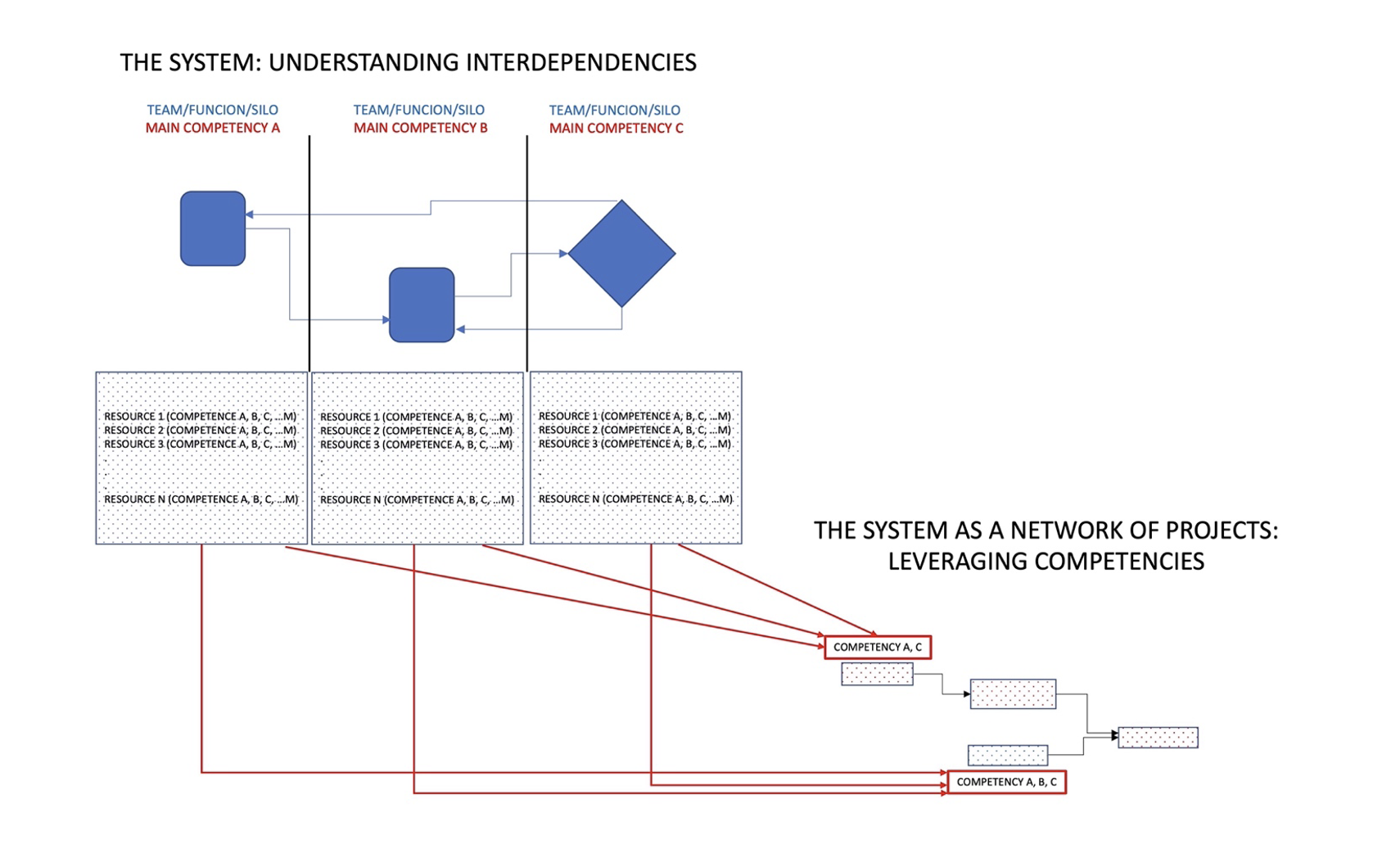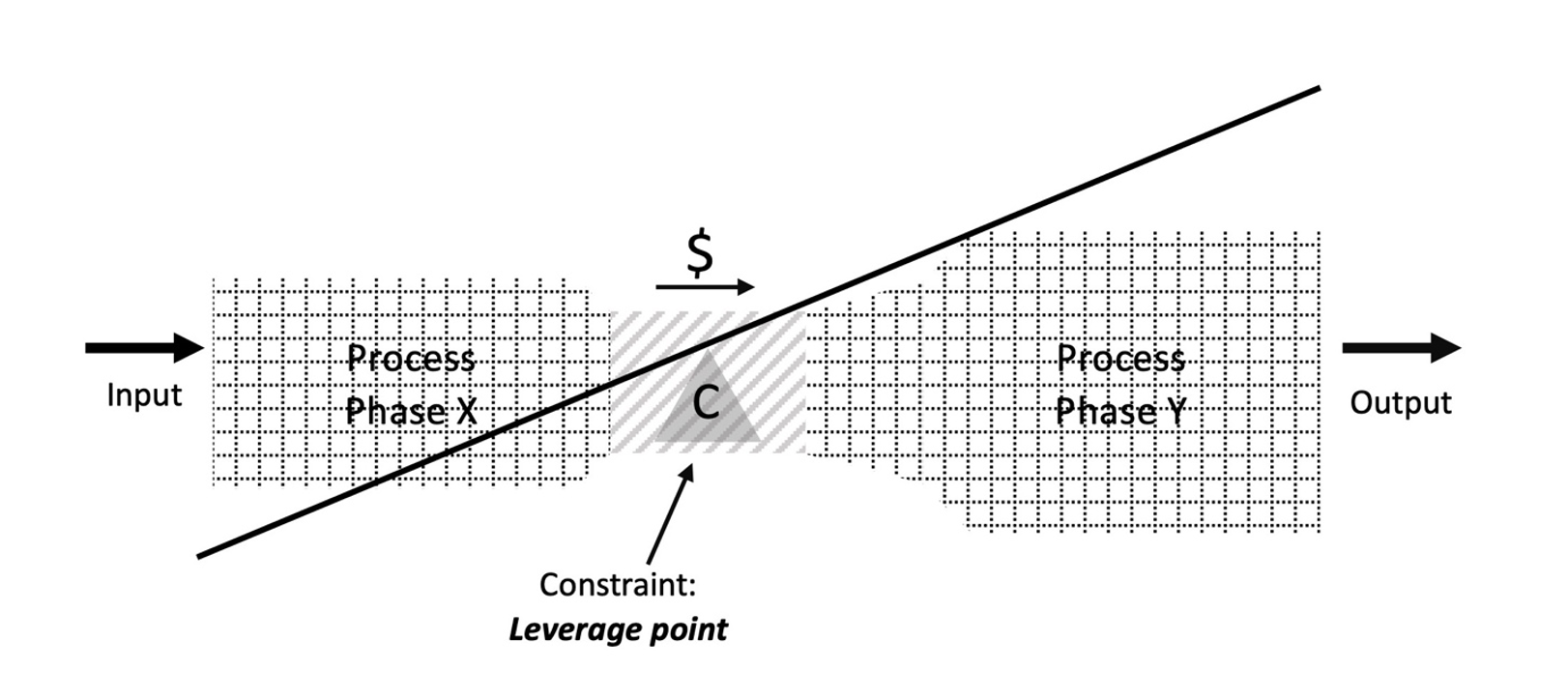
Over the last 25 years, Intelligent Management has invested much of its time investigating how to go beyond the traditional hierarchical organizational structure.
Transitioning from a traditional hierarchical structure to a System is neither immediate nor linear.
One of the most important ways to facilitate this transition is leveraging available competencies within the organization instead of leveraging resources. How can we do this? The transition from hierarchy to System is guided by transitioning from “Process” to “Project”.
It’s all about competencies
Competencies are not limited to what people write in their CVs (i.e. what they have studied, their work experience, etc.). They encompass anything a person is capable of doing.
The diagram below illustrates the way competencies can be deployed in a project:
Associating a competence to a task is a relatively easy job. The real problem arises when you must synchronize the set of tasks to be executed in order to achieve results (a goal).
The role of the Constraint
Synchronization can only happen if there is someone or something that sets the rhythm or pace. We call this the constraint.
We have realized that there are two fundamental sets of activities in any organization:
- Repetitive Processes
- New initiatives (one-off Projects)
For repetitive processes, it is crucial to describe the flow of activities and monitor variation at some key points in order to manage the System.
For Projects, instead, we focus on the synchronization of the different steps of a process through the strategic choice of a physical constraint to which the whole System has to subordinate.
Before we consider the constraint of a project, let’s define the “Constraint” of a system:
The goal that a System pursues will vary depending on the type of organization – whether it is a for-profit company, a Research Centre, a school or a hospital, this goal may be cash, new ideas, new solutions, larger market share, healthy patients, knowledgeable students, etc. The Constraint is the element that dictates the pace at which the System generates units of the goal.
There is a precise name for this pace in the Theory of Constraints: Throughput. Throughput is a time derivative, i.e. units of the goal per unit of time.
The Constraint IS NOT a bottleneck; it is a leverage point in the network. It is the point we strategically choose to generate the highest value for the System. It is an important and delicate choice because we have to subordinate the entire System to the Constraint so that it can always work effectively. This entails creating protection capacity in the System. This is because any minute lost on the constraint is a minute of lost throughput that can never be recuperated.


How do we manage a Constraint?
Dr. Goldratt (who began developing the Theory of Constraints (TOC) in the second part of the Seventies) defined a process named The Five Focusing Steps to manage the Constraint:
- Identify the constraint – choose it strategically
- Exploit (leverage) the constraint – make it work as much and as flawlessly as possible on the optimal product mix – the one with the highest yield
- Subordinate to the constraint – build the whole network of interdependencies in a way that has the statistical capability to support the optimal functioning of the constraint
- Elevate the constraint – increase its capacity
- If the constraint has moved (meaning: if its increase in capacity shifts the existing constraint to a new one) then go back to step 1.
Elevating the Constraint (increase its capacity) implies a broader work on the System in order to keep the Constraint in its strategically chosen position. Basically, before we decide to elevate the strategically chosen constraint, we must increase protection capacity where necessary in the System so that the constraint does not shift.
It is important to understand that if the constraint shifts, then the process of subordination has to be carried out all over again. This, almost unavoidably, creates disruption in the System. It is for this reason that, once we have strategically chosen the Constraint, we really want to keep it where it is.
The constraint of a project
When we talk about Projects, the concept of constraint is a little different.
A Project is a set of actions required to satisfy specifications (often set by a client), in an established timeframe and within a predefined budget.
More precisely:
A Project draws different competencies together in order to accomplish a specified goal, within an agreed upon timeframe and a designated cash outlay.
In the Theory of Constraints, the constraint of a project is its Critical Chain, i.e. the longest sequence of dependent events that takes into consideration the availability of resources (and in our approach, competencies). This chain also defines the lead time for execution of the project, i.e. the realistic length of the project.
This definition is completely coherent with the general definition of constraint because the shorter the critical chain, the faster the project generates value for the organization (Throughput).
To find out more about ten guided steps to a systemic leap ahead for your company, contact Angela Montgomery at intelligentmanagement@sechel.ws
SCHEDULE AN INTRODUCTORY CALL WITH US
Intelligent Management works with decision makers with the authority and responsibility to make meaningful change. We have helped dozens of organizations to adopt a systemic approach to manage complexity and radically improve performance and growth for 25 years through our Decalogue management methodology. The Network of Projects organization design we developed is supported by our Ess3ntial software for multi-project finite scheduling based on the Critical Chain algorithm.
See our latest books Moving the Chains: An Operational Solution for Embracing Complexity in the Digital Age by our Founder Dr. Domenico Lepore, The Human Constraint – a digital business novel that has sold in 43 countries so far by Dr. Angela Montgomery and ‘Quality, Involvement, Flow: The Systemic Organization’ from CRC Press, New York by Dr. Domenico Lepore, Dr. .Angela Montgomery and Dr. Giovanni Siepe.







Leave a Reply